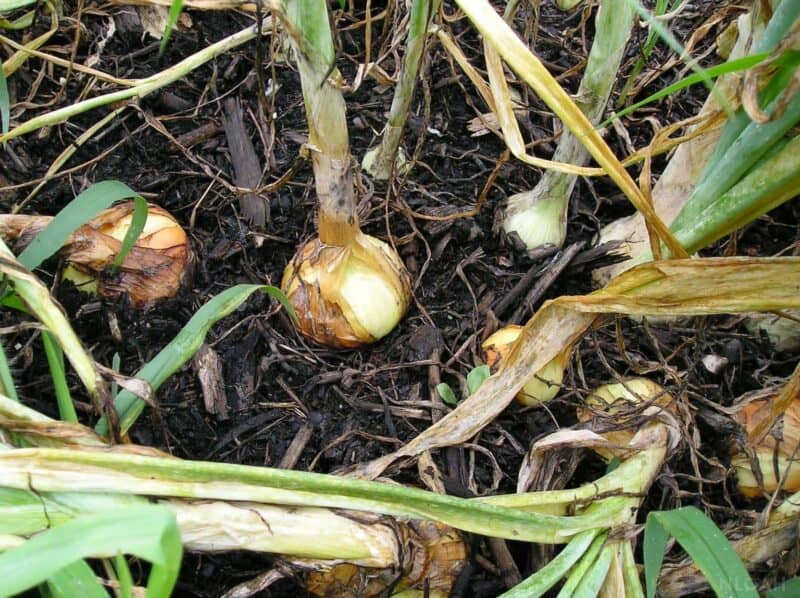Whether you love them or hate them, there is no arguing that onions are one of the most popular and important vegetables around the world.
Onions turn up in so many dishes and as flavoring in other foods that it’s difficult to imagine life without them!

Luckily for gardeners, onions are also hardy and easy to grow, making them a great inclusion in your rotation. If you want to grow onions from seed, how many seeds per hole should you plant?
You should plant at least 2 onion seeds per hole, and as many as 6 if you are working with old seeds that might be questionable. Excess seedlings can be removed or trimmed back as necessary once germination occurs.
The essential thing to know about growing onions from seeds is that you must get the soil requirements just right.
If you can do that, your onions will practically take care of themselves, and they tend to be fairly resistant to diseases and pests.
I’ll tell you everything else that you need to know about growing onions from seeds down below…
How Deep Should You Plant Onions Seeds?
Onion seeds only need to be planted about a quarter of an inch deep, but no more than that. Do not mound soil over the seeds and don’t pack the soil too tightly over the top of them
How Wide Should the Hole for Onions Seeds Be?
The hole for your onion seed doesn’t need to be any wider than 1 inch (2.5 cm). As long as the seeds are buried about a quarter of an inch, they will be good to go.
What Special Preparations Should You Make When Planting Onions Seeds?
As I mentioned above, the most important part about planting onions is getting the soil requirements right. Onions want extremely well-drained soil, and loamy soil is best, ideally with a neutral pH.
But, even though they like well-drained soil onions still need lots of water, requiring about an inch of water or more per week.
But at the same time, it is crucial that the soil only remains damp, never truly wet or soggy because this will cause bulb rot to take hold.
Lots of sunlight is always best for onions, so if you can plant them in a spot that gets at least 6 hours of full sun every day, and preferably more, they will do great.
Also, pay attention to the spacing between plants. Depending on your variety, they’ll need at least 6 inches between them.
Most onions are tolerant of cool weather but they generally want soil temperatures that hover around 50 °F (10 °C).
Your onion seeds will grow fine if the air temperatures are about 40°F and will grow rapidly and temperatures between 65 °F and 80 °F (18 °C and 26 °C).
Also, don’t worry about humidity so much: as long as you’re meeting their water requirements and ensuring that the soil is just staying damp, but not drenched, humidity levels don’t matter very much.
Also, onions are notorious consumers of soil resources: start them off in well-fertilized, nitrogen-rich soil and expect to fertilize them every couple of weeks.
You only need to continue fertilization until the bulb is fully formed and starts to protrude through the surface of the soil.
How Long Until You Can Harvest Onions When Planting from Seed?
Fun fact: you can harvest onions anytime you want, or anytime you need them. Even immature onions that have sprouted can be used as onion greens.
Likewise, you can harvest immature onions that have formed a bulb and prepare them as-is with good results.
But, strictly speaking, your onions will take 12 to 16 weeks to fully mature depending on the cultivar.
Can You Plant Onion Seed Indoors?
Yes, onions can easily be started or even fully grown indoors. You can easily start lots of seeds in trays if you can keep them under grow lights. They’ll need at least 10 hours of light a day in a good potting mix.
Special Care if Planting Onions Seeds Indoors
Growing onions indoors is easy enough if you follow through with the requirements outlined above.
Containers must be adequately-sized to accommodate the mature onions, if that’s what you’re going for, and most varieties will need about a foot of soil depth for proper growth.
In all cases, soil must be extremely well-drained: make sure that the soil stays damp and is not allowed to dry out because this can lead to the forming bulb splitting open with disastrous results.
When it’s time to transplant the onions outdoors wait until the temperatures are hovering around 55 °F (12 °C) prior to moving them outside, and make sure you harden them off.
Take the onions outdoors, and place them in a shady spot for a couple of hours before bringing them back inside.
Repeat the process in the following days, extending the amount of time they stay outdoors by about 30 minutes each time.
Give the process a week, and preferably two weeks, and they’ll be ready for full-time growth outside whether you leave them in containers or transplant them.
Keep in mind, if you don’t want to follow through with hardening off the onions you should expect to lose several of them due to transplant shock.
Tom has lived and worked on farms and homesteads from the Carolinas to Kentucky and beyond. He is passionate about helping people prepare for tough times by embracing lifestyles of self-sufficiency.
